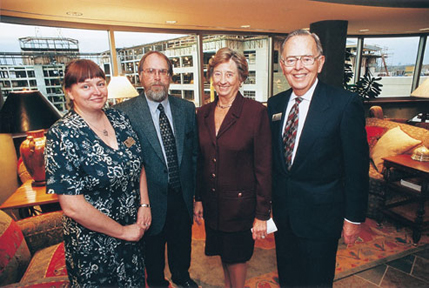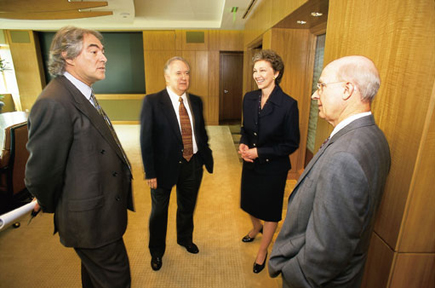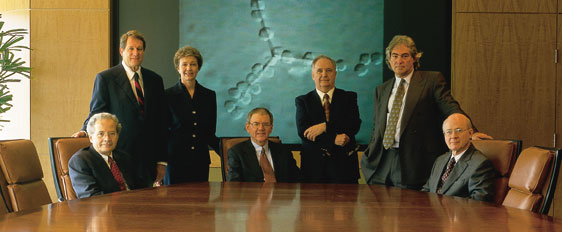|
This month the Kansas City Area Life Sciences Institute presents the
business plan for doing just that - creating a biomedical sciences capitol
that can compete with cities like Boston and San Diego for government
and commercial research funding. This plan has area researchers, educators
and civic leaders fired up about its possibilities.
"We are elated to see that the original spark of interest has now
ignited into a flame," said Marino Martinez-Carrion, Ph.D., dean
of the School of Biological Sciences at the University of Missouri at
Kansas City (UMKC). "It has the potential to place our city among
the very best metropolitan areas in the U.S. in terms of intellectual
activity and academic development."
While many of the elements were already in place to make Kansas City
a life sciences "hub," the community-wide effort, which led
to the establishment of the Life Sciences Institute, began in earnest
in February, 1999. That's when the Kansas City Area Development Council
(KCADA) and the Civic Council established a 25-person task force to evaluate
area resources and to see if Kansas City could become the life sciences
Mecca it hoped to be.

Stowers
Institute's Scientific Director, Dr. Robb Krumlauf and his wife, Dr. Leanne
Wiedemann joins Virginia and Jim stowers, Jr. at the opening of the Institute.
Krumlauf returns from London to begin his work in Kansas City this autumn.
"We enlisted the aid of another 100 other individuals, organized
into work groups focusing on education, research and development, and
commercialization," said John M. Edgar, lead resident partner, Bryan
Cave, LLP, who co-chaired the task force with Mike Morrissey, retired
managing partner, Ernst and Young, LLP.
"We concluded that, 'yes, Kansas City does have the assets here
to support a life sciences center, provided we can achieve collaboration
among the key players,'" Edgar explained.

It's
not inconceivable that in years to come Kansas City will become known as 'Biomed
Valley' for its commitment to biomedical research. Supporters of the movement
say a Kansas City "Biomed Valley" would impart a host of benefits
for the institutions and professionals involved.
Foremost among those key players are Jim and Virginia Stowers who have
already endowed the Stowers Institute for Medical Research with $515 million
and pledged their $1.3 billion estate. The institute's $200 million, 600,000
square foot facility at 50th and Rockhill Road has been designed to create
an environment in which the best and the brightest scientists could come
together to conduct basic genetic research
Indeed, the Stowers Institute has begun to do just that, assembling an
impressive scientific advisory board. The board has already recruited
several top-notch researchers to lead the organization, including William
B. Neaves as president and CEO and Robert E. Krumlauf as scientific director.
"The vision (of a biomedical sciences center) has crystallized around
the Stowers Institute," said David Morrison, M.D., director of medical
research at St. Luke's Hospital and professor of basic medical sciences
at the UMKC School of Medicine. "It is a quality facility, and I
think it will be outstanding in recruiting some first-rate people."
If Stowers has been the catalyst, then certainly the area's universities,
hospitals and research organizations provide the necessary energy.
The University of Missouri-Kansas City (UMKC) School of Biological Sciences,
which offers the only Life Sciences doctoral degrees and postdoctoral
research training in Missouri, specializes in structural biology and molecular
genetics. On the other side of the state line, the University of Kansas
operates the Higuchi Biosciences Center for biomedical research. There,
scientists not only make discoveries but also engage in scientific entrepreneurship.
Another key player, Midwest Research Institute (MRI), conducts applied
research and development in a number of diverse areas. MRI will contribute
expertise in bioanalytical chemistry, automated systems and microelectronics,
as well as its experience in spinning off small research companies and
commercializing technologies.
And, of course, several well-respected hospitals - Children's Mercy Hospital,
St. Luke's Hospital and The University of Kansas Medical Center - conduct
clinical trials to test the efficacy of pharmaceuticals and other therapies.
Together, with the support of private industry including organizations
like Quintiles, Bayer Corp. and Aventis, and several area foundations,
these entities constitute the core group that must manage the amorphous
entity known as the Life Sciences Institute. The Institute crosses city,
county and state lines and involves funding from a number of public and
private sources. And, finally, it requires a substantial infusion of public
and private dollars to lay the groundwork. All of this represents a formidable
undertaking. But William Neaves of the Stowers Institute says Kansas City
can do it.
"I've seen it happen before - at the University of Texas, and, with
the great spirit of collaboration I've seen since I arrived in Kansas
City, it can happen again here," said Neaves, a veteran researcher
who launched a similar biomedical sciences center at University of Texas
Southwestern Medical Center in Dallas in the early 70s.
"It's not inconceivable that in years to come Kansas City will become
known as 'Biomed Valley' for its commitment to biomedical research,"
Neaves added.
Supporters of the movement say a Kansas City "Biomed Valley"
would impart a host of benefits for the institutions and professionals
involved.
"Kansas City will become an even more exciting place to work for
people in the sciences and medicine," notes Ralph E. Kauffman, M.D.
director of medical research at Children's Mercy Hospital and professor
of pediatrics and pharmacology at UMKC. Kauffman believes that the life
sciences initiative will facilitate research in such areas as genetics,
molecular medicine, genomics, human pharmacology, infectious diseases,
cancer and neurosciences.
In vying for grants, the life blood of research organizations, Kansas
City competes with established biosciences centers and often comes up
short. Kansas is one of 23 states which, when combined, receive just 7
percent of NIH (National Institute of Health) monies, according to Michael
A. Welch M.D., Vice Chancellor of Research at the University of Kansas
Medical Center. He notes that Missouri would also be in that group if
it weren't for Washington University in St. Louis.
On the commercialization side, funding is also a challenge, according
to Elias Michaelis, M.D., Ph.D. director of the Higuchi Biosciences Center
and chairman of pharmacology and toxicology at the University of Kansas.
"Frequently when venture capitalists look at us, they say, 'if you
were to start this activity in San Diego, we could get you $20 million
tomorrow. But here, well, we don't know if we want to invest that kind
of money,'" Michaelis explained. "It's a perception, and the
way you overcome that perception is to show that you have the expertise
- scientific expertise, as well as entrepreneurial expertise."
In terms of the local economy, figures from the Life Sciences Institute
indicate that for every $1 spent on basic research, $14 would come back
to the local economy in the form of new jobs and tax revenues. The Stowers
Institute alone will create 300-500 new professional jobs. In that Stowers
and the other key institutions are located in the central city much of
this growth will benefit Kansas City's urban core.
New business and jobs aren't the only advantages the city will enjoy.
Supporters of the life science initiative are convinced that residents
will see an improvement in medical care and an elevation of civic pride.
"As biomedical science activity increases and becomes better known,
it will make people feel better about their own community," said
Michaelis. "Maybe there will come a day when they say, 'Kansas City
offers the best. I don't need to run to Mayo or Chicago or somewhere else.'"
Michaelis offers several other pluses: the new biotechnology companies
not only offer high-paying jobs, but they also produce socially useful
products with minimal negative impact on the environment. The life sciences
movement will accomplish this by bringing clinicians and researchers together
to streamline research, speed breakthroughs and improve patient outcomes.
"For example, it will give us the ability to translate the wonderful
things that happen at Stowers in the field of genetics to the bedside,"
explained Ben D. McCallister, M.D. director of research, Mid-America Heart
Institute. "And, it will allow us to work with colleagues in basic
science and help them develop meaningful research that is solving real
problems that the clinicians and physicians taking care of patients see
every day."
For all the virtues of the Life Sciences, some have expressed doubts
about Kansas City's ability to attract the high level scientists essential
to success. After all, there are no beaches or mountains here, and the
Chiefs haven't won a Superbowl in three decades.
But researchers who have relocated to the area believe that "if
we build it, they will come." The coming will take time, they admit,
maybe 10 to 15 years, but come they will.
"Without a doubt we will attract the best research professionals
to Kansas City," said Andrea Hall, senior vice president and director
of research operations at MRI. "We already boast nationally recognized
experts and institutions in health care and biomedical research. We shouldn't
sell Kansas City short."
So, what must civic leaders do to make Kansas City prepared to attract
these world class scientists?
"We have to be very competitive in recruiting," says Dr. Kauffman
of Children's Mercy. "This requires that we provide the best facilities,
resources and collegial research environment anywhere. We must make it
possible for the scientists we wish to attract to be successful and do
here what they wouldn't be able to do anywhere else."
Kansas City, as a community, must be prepared to devote financial resources
to stimulate this projects' development. Edgar, who co-chairs the Life
Sciences Institute believes we must raise approximately $300 million in
the coming business cycle to develop technologies such as proteomics,
genomics and bioinformatics, as well further support certain underfunded
research projects that will collectively provide the chemistry to elevate
Kansas City as a viable center for biomedical sciences.
Already charitable organizations have stepped forward with seed money
for a variety of projects. In addition to the $1.8 billion commitment
from Jim and Virginia Stowers for the Stowers Institute, the Ewing Marion
Kauffman Foundation and the Hall Family Foundation have pledged $150 million
toward Kansas City's "10 Giant Steps," one of which is the life
sciences initiative. In addition, the Hall Family Foundation has committed
up to $5 million for collaborative efforts in pediatric research, education
and patient care. The interest is there, but there's obviously a long
way to go.
One unanswered question is whether a group of proud, high-achieving, competitive
organizations can put aside their parochial interests to work toward a
common goal.
"The unknown is whether or not we can clear the psychological hurdles
of having people really work together," said David Morrison, M.D.
director of medical research at St. Luke's Hospital and professor of basic
medical sciences at UMKC School of Medicine. "But, there is evidence
that barriers are being broken down, or we would not have come this far."
Indeed a number of alliances have been announced just in the past 18
months. KU Medical Center & Children's Mercy Hospital have announced
a joint effort in pediatric research, education and patient care. Childrens
Mercy and Midwest Research Institute have also formed an alliance called
R.E.A.C.H., the Research Alliance For Children's Health. MRI has also
formed an alliance with KU for joint research and other collaborative
efforts. And Health Midwest and St. Luke's/ Shawnee Mission Health System
have reached an agreement to merge their cancer programs.
"It is very difficult to get over egos, but that is necessary to
achieve our goals," Morrison said. The immediate goal is to break
down institutional boundaries and personal barriers to create an integrated
team, all of whose members work toward the same goal.
"It's important not just to collaborate but to actually integrate,
deciding who will focus on what areas," KU Med's Welch explained.
"In modern science you have to work in teams. New discoveries today
are made by whole teams working together. The human genome project - a
huge task - had different groups working on different areas and putting
their information into one big computer. We should do much the same thing
here. That will deliver the best results and give us more stability and
more long-term benefit to the community."
And once that investment is made, and an integrated life sciences system
is created, officials say Kansas City will have something "no one
can take away from us."
After all, as Welch puts it, "What better industry in which to invest
than the health care of the nation?"
Paula Murray is the President of Prairie Village-based Murray
& Associates who provide consulting and communications services for
the health care industry.
|


